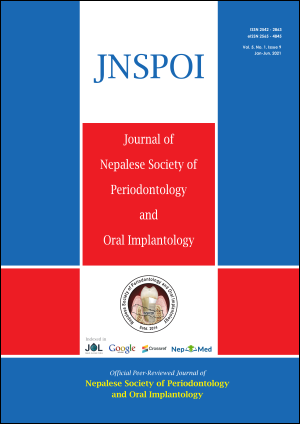Pattern of Malocclusion in Patients undergoing Orthodontic Treatment at a Tertiary Care Teaching Hospital
DOI:
https://doi.org/10.3126/jnspoi.v5i1.38179Keywords:
Angle's classification, malocclusion, orthodontic treatment, patternAbstract
Introduction: Malocclusion can cause dental caries, periodontal disease and aesthetic problems. Malocclusion is most common dentofacial abnormality found in human population. However, the awareness for orthodontic treatment is increasing.
Objective: The aim of this research was to evaluate pattern of malocclusion in patients undergoing orthodontic treatment at Nobel Medical College Teaching Hospital of Biratnagar, Nepal.
Methods: Two hundred and eighty preoperative study casts (2018 Jun to 2020 Jun) of orthodontic patients aged from 12-55 years were selected from 680 patient’s records of department of orthodontics of Nobel medical college teaching hospital, Biratnagar. Standard protocol of Angle’s classification of malocclusion was used to classify malocclusion and its traits were recorded. Data were entered in Microsoft Excel and descriptive statistics were calculated.
Results: The prevalence of malocclusion were 59.65% (167) of Angle’s class I, 35.71% (100) of Angle’s class II and 4.64% (13) of Angle’s class III malocclusion. Among various attributes of malocclusion, deep bite was the most common trait (188, 67.14%). Increased overjet was found in 169 (60.35%) subjects. Crowding and spacing were found in 164 (58.57%), and 109 (38.92%) respectively.
Conclusion: Angle’s class I malocclusion is most prevalent malocclusion seen followed by Angle’s class II and Angle’s class III.
Downloads
Downloads
Published
How to Cite
Issue
Section
License
© Nepalese Society of Periodontology and Oral implantology (NSPOI)
Licenced by Creative Commons Attribution 4.0 International License.




